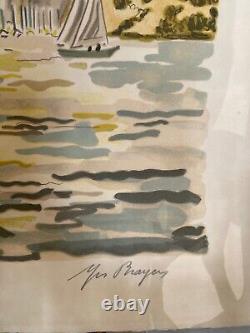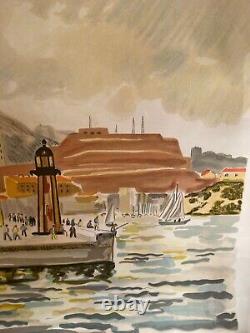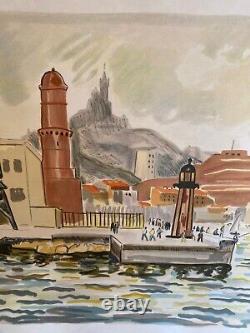
- Index
- Authenticity
- Characteristics
- Genre
- Abstract (92)
- Abstrait (363)
- Art Deco (52)
- Art Déco (109)
- Art Moderne (10)
- Art Naïf (30)
- Art Nouveau (97)
- Cubisme (26)
- Expressionism (53)
- Expressionnisme (162)
- Fauvisme (13)
- Modern (53)
- Moderne (18)
- Naive Art (21)
- Pop Art (40)
- Street Art (62)
- Streetart (87)
- Surrealism (23)
- Surréalisme (103)
- Symbolisme (14)
- Other (1418)
- Style
- Support
- Type
Original signed lithograph, Yves Brayer, numbered VI/XX, The Fort St Nicolas









From 1974, "Le Fort Saint Nicolas", view from the Joliette pier in Marseille. INFORMATION: Taken from the portfolio "Marseille" by Jean Boissieu, Agori editions. Printed at the Gaillard Gourdon workshops, Cachan on July 30, 1974. Yves Brayer was among the painters who, between the two world wars, felt the need to connect with the reality around them. They rejected, without completely ignoring, the artistic movements of the late 19th and early 20th centuries, aspiring instead to be disciples of Vuillard and Bonnard, like the group of Poetic Reality, or admirers of Courbet, like the Forces Nouvelles movement.
While Brayer always remained independent, he counted Francis Gruber among his friends, who was the originator of the French New Realism of the 1950s, with Bernard Buffet as a brilliant example. Yves Brayer was born in Versailles in 1907, but spent most of his childhood in Bourges. Upon arriving in Paris in 1924, he entered the academies of Montparnasse and later the School of Fine Arts.
At a young age, he showcased his personality, encouraged by older artists like Jean-Louis Forain. Still a student, he exhibited at the Salon d'Automne and the Salon des Indépendants. In 1927, a state travel grant allowed him to go to Spain, where meeting the masters of the Prado Museum would have a decisive influence on his future work. After a stay in Morocco thanks to a prize created by Marshal Lyautey, he won the Grand Prix de Rome in 1930. Initially, he missed Spain, but soon he was swept away by the richness of Italian life in the 1930s.
Upon his return to Paris in 1934, he gathered his work for a major exhibition at the Galerie Charpentier, in the Saint-Honoré district, where the public discovered the authenticity of this powerful and original twenty-seven-year-old painter. Paris remained his home base, and after living in the Panthéon district, he settled in 1935 on Rue Monsieur le Prince in the sixth arrondissement. During various periods, he painted in Paris while still a student, from 1926 to 1929. Demobilized in Montauban, he moved to Cordes sur Ciel in the Tarn in 1940. A museum dedicated to him was established in the most beautiful room of the town hall in 1960. In 1942, he returned to the capital where Jacques Rouché commissioned him to create his first model designs for sets and costumes for a ballet at the Paris Opera. He remained there during the occupation, painting the snow-covered city and then the liberated city. The year 1945 marked a new stage in his work. In Provence, he realized that there were other harmonies beyond those of human-made architecture, those of pure and wild nature, and he soon became fascinated by the diversity of the Alpilles and their limestone folds, and then by the expanses of the Camargue populated by white horses and black bulls. He soon settled in Provence for several months each year.After his dark Spanish period and his ochre and red Italian phase, he diversified his palette by introducing greens, pale yellows, and some blues. Strongly attracted by Mediterranean landscapes, he returned to work in Spain and Italy, but Provence and Camargue remained his preferred places until the end of his life. He undertook various trips to Mexico, Egypt, Iran, Greece, Russia, the United States, and Japan.
Quickly capturing the light and rhythms of these countries, he returned with numerous drawings and watercolors. His taste for graphics naturally led him to practice copper engraving and lithography; thus, he created many prints and illustrated limited edition books with texts by Blaise Cendrars, Henry de Montherlant, Baudelaire, Paul Claudel, Jean Giono, Frédéric Mistral, etc. Yves Brayer is also the author of wall decorations, tapestry cartoons, set and costume designs for the Théâtre-Français, and the Operas of Paris, Amsterdam, Nice, Lyon, Toulouse, Bordeaux, and Avignon. His solo exhibitions made his works familiar in many countries: first in Paris, then in France, Europe, and the United States. The National Library presented "Yves Brayer, Engraver" in 1977 for his seventieth anniversary, and the Postal Museum dedicated an exhibition of his works at the time of the stamp commissioned in 1978. Finally, the YVES BRAYER MUSEUM was inaugurated in September 1991 in Les Baux de Provence. He is present in various museums and numerous collections both in France and abroad.He taught at the Académie de la Grande Chaumière for fifty years, was President of the Salon d'Automne for five years, and, as a member of the Académie des Beaux-Arts, served as curator of the Marmottan Museum in Paris for over eleven years.

